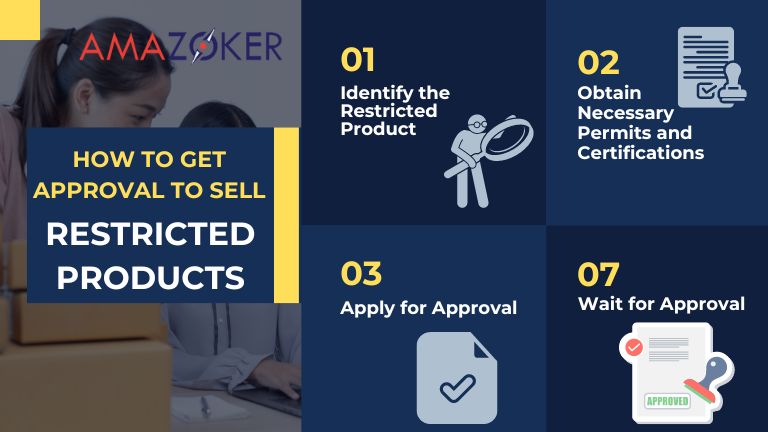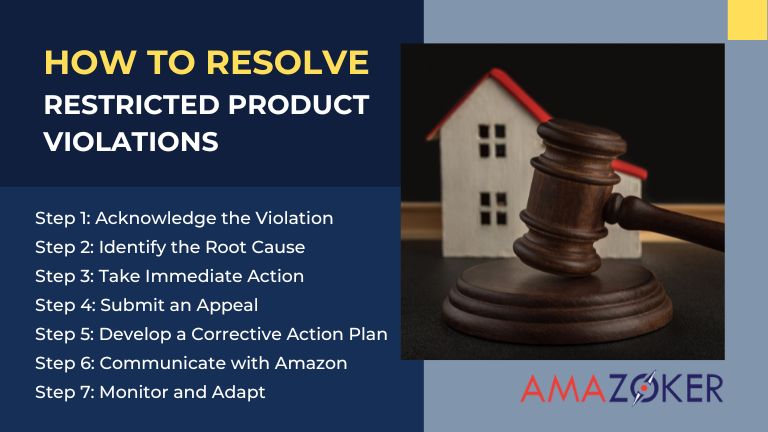Amazon has a list of restricted products that cannot be sold without proper approval. These restrictions are in place to ensure the safety and satisfaction of customers, as well as to comply with legal regulations. As a seller, it is important to understand how to sell Amazon restricted products and the consequences of failing to comply with their policies.
Table of Contents
How To Get Approval To Sell Amazon Restricted Products
Amazon has strict guidelines for selling restricted products, and obtaining approval can be a lengthy process. However, it is necessary to follow these steps in order to legally sell these products on the platform.

Steps to Gain Approval for Selling Amazon Restricted Products
Step 1: Identify the Restricted Product
The approval process varies depending on the nature of the product. Certain items, such as pharmaceuticals, weapons, and copyrighted materials, are inherently restricted and necessitate a thorough vetting process.
The first step is to identify if the product you want to sell is on Amazon’s restricted list. This list can be found on Amazon’s Seller Central website under the “Restricted Products” section. It is important to note that this list is constantly updated, so it is crucial to check it regularly.
Step 2: Obtain Necessary Permits and Certifications
Certain products require specific permits or certifications in order to be sold on Amazon. For example, if you want to sell dietary supplements, you will need to obtain a Food and Drug Administration (FDA) registration number. It is important to research and obtain all necessary permits and certifications before applying for approval to sell Amazon restricted products.
Step 3: Apply for Approval
Once you have identified the restricted product and obtained all necessary permits and certifications, you can apply for approval to sell Amazon restricted products. The application process varies depending on the product category, but it usually involves providing detailed information about the product, including its ingredients, manufacturing process, and any relevant certifications. It is crucial to provide accurate and comprehensive information to expedite the approval timeline.
Step 4: Wait for Approval
After submitting your application, it can take anywhere from a few days to several weeks to receive approval. It is important to be patient and not rush the process, as Amazon will thoroughly review all applications to ensure compliance with their policies. Moreover, maintaining transparent communication with Amazon’s Seller Support team can facilitate the approval process and address any queries or concerns that may arise.
What Can Happen If You Fail To Comply With Amazon Restricted Products Policy?
Amazon has strict consequences for sellers who do not comply with their restricted products policy. These consequences can range from cancellation of listings to account suspension or even being banned from selling on Amazon altogether.

The consequences of not adhering to Amazon’s restricted products policy
Cancellation of Listing
If you are found to be selling a restricted product without proper approval, Amazon will immediately cancel your listing. This means that your product will no longer be available for purchase on the platform. Additionally, any inventory you have in Amazon’s fulfillment centers will be disposed of at your expense.
Account Suspension
In more severe cases, Amazon may suspend your seller account if you repeatedly violate their restricted products policy. This means that you will not be able to sell any products on Amazon until the issue is resolved. Account suspension can have a significant impact on your business, as it can result in loss of sales and damage to your reputation as a seller.
Banned from Amazon
If you continue to sell Amazon restricted products after multiple warnings and suspensions, you may be permanently banned from selling on the platform. This is a serious consequence that can have long-lasting effects on your business. Once banned, it is extremely difficult to get reinstated as a seller on Amazon.
How To Resolve Restricted Product Violations
If you find yourself in violation of Amazon’s restricted products policy, you must take immediate and decisive action to rectify the situation and mitigate potential repercussions. The following steps can guide you through the resolution process.

Strategies for Resolving Violations of Restricted Products
Step 1: Acknowledge the Violation
Upon receiving notification of a violation, it is imperative for sellers to acknowledge the issue promptly. Denying or ignoring the violation can exacerbate the situation and erode Amazon’s trust in the seller.
Step 2: Identify the Root Cause
Sellers should conduct a thorough internal review to identify the root cause of the violation. This may involve scrutinizing internal processes, supplier relationships, and product sourcing practices to pinpoint the lapse in compliance. Once you understand the issue, you can take the necessary steps to resolve it.
Step 3: Take Immediate Action
If your listing has been cancelled or your account has been suspended, it is important to take immediate action. This could involve removing the product from your inventory, providing additional information to Amazon, or correcting any misleading information on your listing.
Step 4: Submit an Appeal
If your account has been suspended or you have been banned from selling on Amazon, you can submit an appeal to Amazon’s Seller Performance team. In your appeal, you should explain the steps you have taken to resolve the issue and provide any necessary documentation to support your case. It is important to be honest and transparent in your appeal, as Amazon takes violations of their policies very seriously.
Step 5: Develop a Corrective Action Plan
Based on the identified root cause, sellers should formulate a comprehensive corrective action plan. This may involve revising internal policies, enhancing product documentation, or seeking additional certifications or approvals.
Step 6: Communicate with Amazon
Open and transparent communication with Amazon’s Seller Support team is crucial during the resolution process. Sellers should clearly articulate the corrective measures being implemented and provide evidence of their commitment to compliance.
Step 7: Monitor and Adapt
Following the resolution of a violation, sellers must remain vigilant and continually monitor their operations to prevent future infractions. Adapting internal processes and staying abreast of regulatory changes is essential to maintaining compliance.
How to sell Amazon restricted products can be a profitable venture, but it is crucial to follow Amazon’s guidelines and obtain proper approval before listing these products. Failure to comply with their policies can result in serious consequences, including cancellation of listings, account suspension, or being banned from selling on the platform. By understanding how to sell Amazon restricted products and the consequences of non-compliance, you can ensure a successful and compliant business on the platform.











